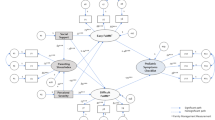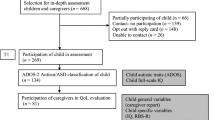Abstract
The objective was to examine the association of parental locus of control (PLOC) with pediatric quality of life (QOL) for children with sickle cell disease (SCD), specifically addressing the potential mediating role of family functioning. Associations with disease severity were also investigated. Thirty-one primary caregivers completed standard measures of parental locus of control, family functioning, and quality of life during their child's inpatient admission for pain or fever. Results indicated that the PLOC total score was significantly associated with QOL in terms of self-competence and showed marginal significance with QOL social competence; it was significantly negatively correlated with family functioning. The association of the PLOC with QOL subscales was maintained when controlling for family functioning. Disease severity was not associated with PLOC scores. Primary caregivers endorsed more external parental locus of control beliefs. Further investigation of the association of caregiver appraisals and family functioning is warranted with the goal of addressing the stress that disease management with sickle cell may add to parent–child relationships.
Similar content being viewed by others
References
Armstrong, D. (1999). The Miami Pediatric Quality of Life Questionnaire: Parent Scale. International Journal of Cancer, Suppl. 12, 11–17.
Bagner, D. M., Fernandez, M. A., & Eyberg, S. M. (2004). Parent–child interaction therapy and chronic illness: A case study. Journal of Clinical Psychology in Medical Settings, 11(1), 1–6.
Beyer, J. E., & Simmons, L. E. (2004). Home treatment of pain for children and adolescents with sickle cell disease. Pain Management Nursing, 5(3), 126–135.
Barakat, L. P., Lash, L., Lutz, M. J., & Nicolaou, D. C. (2005). Psychosocial adaptation of children and adolescents with sickle cell disease. In R. T. Brown (Ed.), Pediatric Hematology/Oncology: A Biopsychosocial Approach. New York: Oxford University Press.
Barakat, L. P., Smith-Whitley, K., & Ohene-Frempong, K. (2002). Treatment adherence in pediatric sickle cell disease: Disease-related risk and psychosocial resistance factors. Journal of Clinical Psychology in Medical Settings, 9, 201–209.
Brown, R. T., Doepke, K. J., & Kaslow, N. J. (1993). Risk-resistance adaptation model for pediatric chronic illness: Sickle cell syndrome as an example. Clinical Psychology Review, 13, 119–132.
Brown, R. T., & Lambert, R. (1999). Family functioning and children's adjustment in the presence of a chronic illness: Concordance between children with sickle cell disease and caretakers. Family, Systems and Health, 17(2), 165–179.
Brown, R. T., Lambert, R., Devine, D., Baldwin, K., Casey, R., Doepke, K., Ievers, C. E., Hsu, L., Buchanan, I., & Eckman, J. (2000). Risk-resistance adaptation model for caregivers and their children with sickle cell syndromes. Annals of Behavioral Medicine, 22, 158–169.
Burlew, A. K., Evans, R., & Oler, C. (1989). The impact of a child with sickle cell disease on family dynamics. Annals of the New York Academy of Sciences, 565, 161–171.
Campis, L. K., Lyman, R. D., & Prentice-Dunn, S. (1986). The parental locus of control scale: Development and validation. Journal of Clinical Child Psychology, 15(3), 260–267.
Casey, R., Brown, R. T., & Bakeman, R. (2000). Predicting adjustment in children and adolescents with sickle cell disease: A test of the risk-resistance—Adaptation model. Rehabilitation Psychology, 45, 155–178.
DeMaso, D. R., Campis, L. K., Wypij, D., Bertam, S., Lipshitz, M., & Freed, M. (1991). The impact of maternal perceptions and medical severity on the adjustment of children with congenital heart disease. Journal of Pediatric Psychology, 16(2), 137–149.
Epstein, N. B., Baldwin, L. M., & Bishop, D. S. (1983). The McMaster Family Assessment Device. Journal of Marital and Family Therapy, 9, 171–180.
Hurtig, A. L., Koepke, D., & Park, K. B. (1989). Relation between severity of chronic illness and adaptation in children and adolescents with sickle cell disease. Journal of Pediatric Psychology, 14(1), 117–132.
Ievers-Landis, C. E., Brown, R. T., Drotar, D., Bunke, V., Lambert, R. G., & Walker, A. A. (2001). Situational analysis of parenting problems for caregivers of children with sickle cell syndromes. Journal of Developmental and Behavioral Pediatrics, 22(3), 169–178.
Kabacoff, R. I., Miller, I. W., Bishop, D. S., Epstein, N. B., & Keitner, G. I. (1990). A psychometric study of the McMaster Family Assessment Device in psychiatric, medical, and nonclinical samples. Journal of Family Psychology, 3(4), 431–439.
Kaslow, N. J., & Brown, F. (1995). Culturally sensitive family interventions for chronically ill youth: Sickle cell disease as an example. Family Systems Medicine, 13(2), 201–213.
Kazak, A. E., Rourke, M. T., & Crump, T. A. (2003). Families and other systems in pediatric psychology. In M. C. Roberts (Ed.), Handbook of Pediatric Psychology (3rd ed., pp. 159–175). New York: Guilford.
Lemanek, K. L., Ranalli, M. A., Green, K., Biega, C., & Lupia, C. (2003). Diseases of the blood: Sickle cell disease and hemophilia. In M. C. Roberts (Ed.), Handbook of Pediatric Psychology (3rd ed., pp. 321–341). New York: Guilford.
Lutz, M. J., Barakat, L. P., Smith-Whitley, K., & Ohene-Frempong, K. (2004). Psychological adjustment of children with sickle cell disease treated in an acute care unit: The role of family functioning and coping. Rehabilitation Psychology, 49(3), 224–232.
Miller, I. W., Epstein, N. B., Bishop, D. S., & Keitner, G. I. (1985). The McMaster Family Assessment Device: Reliability and validity. Journal of Marital and Family Therapy, 11, 345–356.
Morton, T. L. (1997). The relationship between parental locus of control and children's perceptions of control. The Journal of Genetic Psychology, 158(2), 216–226.
Mouton, P. Y., & Tuma, J. M. (1988). Stress, locus of control, and role satisfaction in clinic and control mothers. Journal of Clinical Child Psychology, 17(3), 217–224.
National Heart, Lung, and Blood Institute (NHLBI). (2002). The Management of Sickle Cell Disease (4th ed.). NIH Publication No. 02–2117.
Noll, R. B., McKellop, J. M., Vannatta, K., & Kalinyak, K. (1998). Child-rearing practices of primary caregivers of children with sickle cell disease: The perspective of professionals and caregivers. Journal of Pediatric Psychology, 22(2), 131–140.
O'Connor, T. G. (2002). Annotation: The ‘effects’ of parenting reconsidered: Findings, challenges, and applications. Journal of Child Psychology and Psychiatry, 43(5), 555–572.
Radcliffe, J., Barakat, L. P., & Boyd, R. (2005). Family issues. In R. T. Brown (Ed.), Pediatric Hematology/Oncology: A Biopsychosocial Approach. New York: Oxford University Press.
Roberts, M. W., Joe, V. C., & Rowe-Hallbert, A. (1992). Oppositional child behavior and parental locus of control. Journal of Clinical Child Psychology, 21(2), 170–177.
Rotter, J. B. (1966). Generalized expectancies for internal versus external control of reinforcement. Psychological Monographs, 80(1, Whole No. 609).
Spieth, L. E. (2001). Health-related quality of life measures for children and adolescents. In H. M. Koot & J. L. Wallander (Eds.), Quality of Life in Child and Adolescent Illness: Concepts, methods, and findings (pp. 49–88). East Sussex: Brunner-Routledge.
Streisand, R., Braniecki, S., Tercyak, K. P., & Kazak, A. E. (2001). Childhood illness-related parenting stress: The pediatric inventory for parents. Journal of Pediatric Psychology, 26(3), 155–162.
Thompson, R. J., Jr., Gustafson, K. E., Gil, K. M., Kinney, T. R., & Spock, A. (1999). Change in psychological adjustment of children with cystic fibrosis or sickle cell disease and their mothers. Journal of Clinical Psychology in Medical Settings, 6, 373–392.
Wallander, J. L., Varni, J. W., Babani, L., Banis, H. T., & Wilcox, K. T. (1988). Family resources as resistance factors for psychological maladjustment in chronically ill and handicapped children. Journal of Pediatric Psychology, 14, 157–173.
Author information
Authors and Affiliations
Corresponding author
Rights and permissions
About this article
Cite this article
Barakat, L.P., Lutz, M.J., Nicolaou, D.C. et al. Parental Locus of Control and Family Functioning in the Quality of Life of Children with Sickle Cell Disease. J Clin Psychol Med Settings 12, 323–331 (2005). https://doi.org/10.1007/s10880-005-7818-9
Issue Date:
DOI: https://doi.org/10.1007/s10880-005-7818-9




